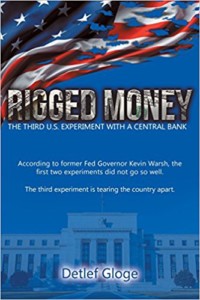Title: Rigged Money: The Third U.S. Experiment with a Central Bank
Author: Detlef Gloge
Publisher: Toplink Publishing
ISBN: 978-1947620759
Pages: 76
Genre: Non-Fiction, Textbook, economic Expert Subject Matter
Reviewed by: Dontas Pranskevicius Special Contributor to Pacific Book Review
Pacific Book Review Star
Awarded to Books of Excellent Merit

Author and economist Detlef Gloge has boiled down, condensed factual information ascertained by scores of economists and sentence after sentence, has built the foundation of the premise, which defines the root cause of the shrinking wealth of the middle class and the growth of the wealthy. Dr. Gloge peels the onion on the complex banking and government actions of printing money, revealing a myriad of reasons for what in the end is compared to a form of a Ponzi scheme, in his book titled Rigged Money : The Third U.S. Experiment with a Central Bank. While Bernie Madoff is in jail as Alan Greenspan is celebrated for essentially allowing for the growth of our public debt to such a huge level the government’s only solution is to print new money to simply pay off the existing interest on the initial debt. Oddly nobody is talking about what everybody knows, which is the government will never be able to pay off its debt.
Detlef Gloge has condensed the economic truisms and beliefs, trends and definitions of the economists known to most of us, including John Maynard Keynes, father of Keynesian Economics who stated lower taxes and more money will pull the country out of the depression of the 1930s. Also referenced is Milton Friedman, known for his model of free market capitalism. In fact the book’s Notes at the end total over ten pages of crediting the work of others, including Dr. Gloge’s prior publications. Rigged Money is a summation of explanations and theories which are concise, matter-of-fact, written clearly and very objectively in what is a sober look at the sorry state of the economy of the US Banking system in this 21st Century. Each sentence builds upon previously defined terms and trends, resulting in his book clearly explaining how the printing of money without having precious metal backing along with the artificial manipulation of interest rates are reducing the wealth of the middle class while making the wealthy richer. He exposes the role of banking as being for what they are, a group of for-profit entities with their profits depending on the difference of the two interest rates; those charged to borrowers for loans and those paid to depositors.
Subtle economic trends such as regressive confiscation of wealth, are explained with its effect on the social strata of society; for example how a New York stock trader is generally known to make more income than a mid-western farmer, yet the two “classes” seem to understand this and live within their economic values. The boom of the Roaring 20’s and the bust of the 2008 mortgage crisis are shown with clarity of cause and effect for the decisions made with economic policies. These challenging and complex ebbs and flows of money are explained with such scholastic confidence and acumen to detail in which Dr. Gloge brings into his book the essence of volumes of research done by others and summarizes it for all to understand; albeit the intellectual and factual density of the presentation is extremely high. Impeccably written and outlined with chapters alerting the reader to the pathway for the author’s logical dissemination of information, Rigged Money reads as if it is a textbook for graduate level courses.
“Today, this game is deteriorating for even the key players. There is simply too much debt, wealth disparity, and economic stagnation.” There is no easy way out, and eminent doom may be inferred by such an unavoidable end game. It shows that the very best ideological systems are only the product of human nature and reflect its flaws and contortions. Don’t blame ‘the banks’; look carefully at the bankers. I recommend you buy this book right away, while your money is still having purchasing power. As it is the money creation, not inflation, which lowers the wealth of the middle and lower classes of earners. This book is an excellent resource for anyone interested in economics, finance, and banking and helps understand today’s modern-day financial markets.


